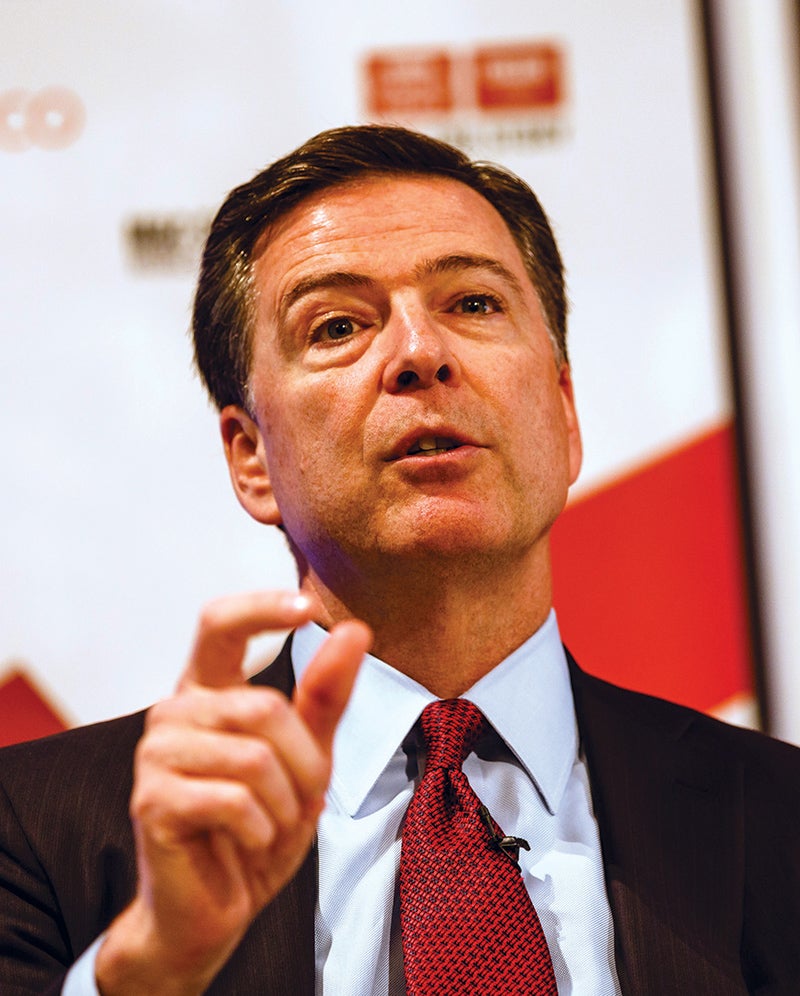
The Institute headed to London in April for the debut of the Aspen Security Forum: Global, an international complement to the more US-focused discussions at the annual Aspen Security Forum. The event convened top-level government officials, journalists, and international-security experts to discuss the world’s gravest threats. The forum kicked off with a conversation with FBI Director James Comey about why so much of the FBI’s work is now done in cyberspace.
On hacking the San Bernardino terrorist’s iPhone:
I don’t want to pick on Apple. The Justice Department brought litigation as part of the FBI investigation into the San Bernardino attack. It was important to get into the phone to competently investigate a terrorist attack. We should have been fired if we didn’t try to see what was in a terrorist’s phone. But we got to a place where Apple—and I’m not questioning their motives—was not willing to cooperate. In the end, we got into the phone because all the controversy and attention stimulated a bit of an international marketplace for people to figure out how to break into an Apple 5C running iOS 9, the phone the terrorist left behind.
Somebody approached us from outside the government and said, “We’ve come up with a solution.” The FBI tested it, and tested it, and tested it, and then we purchased it. Once we knew it would work, we withdrew the litigation. That’s a good thing. First, we got into the phone, which was very important to the investigation. Second, litigation is not a great way to resolve hard values questions. But we should continue to talk about it, because all of us share a set of values that are in conflict, and we have to figure out how to resolve privacy and security on the Internet. They’re crashing into each other in terrorism cases and in all the work the FBI does.
On the shift from Al Qaeda to ISIL:
Al Qaeda focused on sophisticated long-planned attacks with extensive surveillance and carefully-vetted operatives. In a way, we had come to rely on Al Qaeda’s culture. If Al Qaeda just shot a bunch of people in a restaurant, that would be a loss of face, a confession of weakness. That was the Al Qaeda model. That changed in 2014 and accelerated with ISIL, whose mission was simply to attract people to their caliphate or kill. “Come or kill” was the message: Come or kill. Kill anybody in the name of the Islamic State, or come and become a soldier of the caliphate. That’s the first big change. The second is the way they communicated that message. It made Al Qaeda look like your parents’ Al Qaeda. ISIL crowd-sourced terrorism by pushing out that twin message—especially on Twitter—in a very slick way.
The message was one of ultimate meaning—one that resonated with troubled, unmoored souls. And the message would buzz in their pockets 24 hours a day: Come or kill, find meaning. Then, to make it more complicated, ISIL would find people interested in traveling or killing on their behalf and move them off the open platform of Twitter. ISIL would move them to a mobile-messaging app, encrypted end to end. So they’re crowd-sourcing terrorism, constantly broadcasting a meaningful message to troubled souls, and when they get one who’s likely to act, ISIL makes him invisible. That’s a totally different model than we’ve ever seen. All of a sudden we had people all over the country moving quickly along the spectrum from consuming to acting. We had to lock up and disrupt the plots of dozens of people—people that Al Qaeda would never have used: drug users, pedophiles, criminals, the mentally ill. The last nine months, however, the number of attempted travelers from the States has been steadily coming down. It could also be that it has finally dawned on people that their so-called caliphate is hell on Earth.

